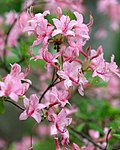| Rhododendron prinophyllum | |
|---|---|
 | |
| Scientific classification | |
| Kingdom: | Plantae |
| Clade: | Tracheophytes |
| Clade: | Angiosperms |
| Clade: | Eudicots |
| Clade: | Asterids |
| Order: | Ericales |
| Family: | Ericaceae |
| Genus: | Rhododendron |
| Subgenus: | Rhododendron subg. Hymenanthes |
| Section: | Rhododendron sect. Pentanthera |
| Species: | R. prinophyllum |
| Binomial name | |
| Rhododendron prinophyllum (Small) Millais | |
| Synonyms [2] | |
| |
Rhododendron prinophyllum, the early azalea, [2] is a rhododendron species native to the eastern and southern United States. It is a deciduous shrub that usually grows 4 to 8 feet in height, rarely reaching 15 feet. Flowers are pink. [3]






